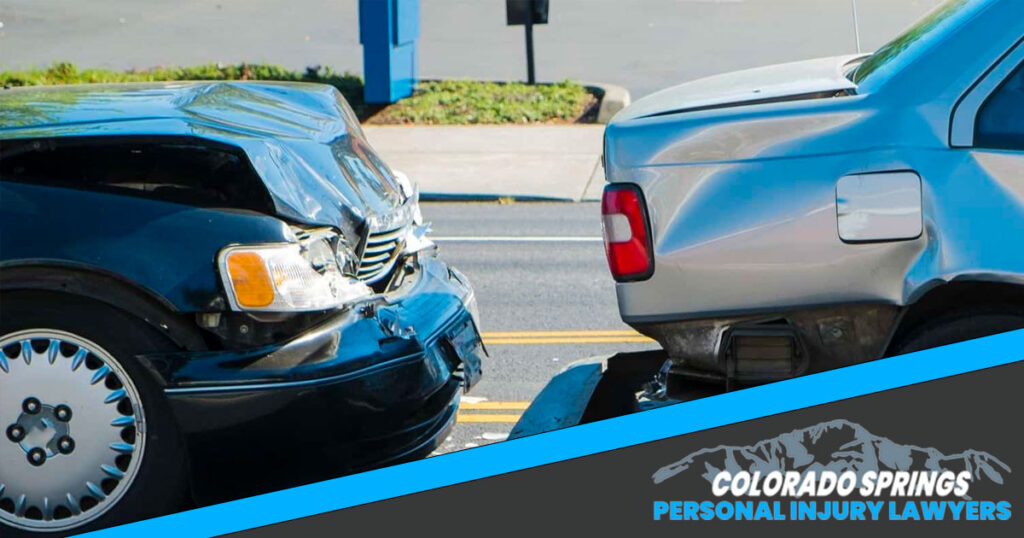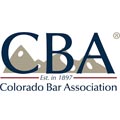Updated January 30, 2025 by Sean McQuaid
Most drivers across the country have been involved in some sort of car accident at varying degrees of severity. As urban populations rise, increasing the number of vehicles on the road, car accidents have become a familiar and unfortunate daily occurrence in every city in the U.S. at a rate of 1 accident every 13 minutes, according to the Bureau of Labor.
Colorado Springs has seen massive growth in recent years as development increases with more home building, expanding neighborhoods, and new restaurants and businesses opening to accommodate the number of new people coming to the area. As the number of residents along with the large number of visitors increases, so does the number of drivers on the road, adding to high traffic volumes, road congestion, and raising the chances of car accidents.
Rear-end collisions are among the most common types of car accidents associated with high traffic volumes and bumper-to-bumper driving in and around the city. Patience is a virtue when dealing with rush hour gridlock, congestion from road closures, or weekend visitor traffic, especially in the winter season. Unfortunately, impatient drivers trying to reach their destination in a hurry when traffic is moving slowly only increases the risk of fender-benders or more serious rear-end car accidents resulting in severe injury.
These types of accidents can be minor and obvious who the driver at fault is, or more complex circumstances can contribute to fault being shared by drivers, particularly if the accident involves more than two vehicles. The following article will investigate the causes and injuries associated with rear-end collisions and how fault is determined in a Colorado Springs rear-end car accident.
Who Is at Fault and Liable in a Rear-End Car Accident in Colorado Springs?
Determining fault after a rear-end car accident can be complicated. In most cases, if you were rear-ended, the other driver is usually at fault and liable. It will be necessary to prove that you were not at fault, especially if you were forced into a vehicle stopped ahead of you, resulting in another rear-end collision with one or more vehicles. An experienced Colorado Springs car accident lawyer can ensure your claim is solid by gathering the critical information and evidence needed to determine fault and get a fair settlement from insurance providers.
Can The Person That Was Rear-Ended Be at Fault?
In the unfortunate event of a rear-end car accident, the driver in the back is generally the one deemed responsible. There are instances, however, where the driver in front may also bear responsibility for the accident if they have contributed by their own negligence. Circumstances that could lead to the driver of a rear-ended vehicle being liable or partially liable include:
- Abruptly hitting the brakes and stopping without reason.
- Backing up into another vehicle after stopping.
- Driving without adequately functioning brake lights.
- Merging without enough distance between or speed.
- Sudden stopping after initiating a turn.
- Driving while distracted.
- Reckless and negligent behavior.
The Colorado Department of Motor Vehicles recommends exercising the three-second rule when following another vehicle to help avoid situations that can lead to a rear-end collision. This rule requires the driver to maintain a distance that allows for a three-second interval between their vehicle and the car in front. It is also expected that the driver should be prepared to stop with enough distance between their vehicle and the car ahead by ensuring the car’s rear wheels are visible.
Can Both Parties Be Partially Liable?
Colorado operates a modified comparative fault system, meaning if each party involved contributed to the circumstances of the rear-end car accident, they could be held liable based on the percentage of each was at fault. This also means that you can only claim against the other driver if you contribute less than 50% to the accident and that your claim for damages will be affected by your percentage of fault. For example, If you are found to be 49% or less at fault, you can recover 51% or more for your damages. However, suppose you are found to be 50% or more at fault. In that case, you will not receive any compensation from the other party’s insurance provider.
Common Causes of Colorado Springs Rear-End Car Accidents
Many cars on the roads today are equipped with proximity warning sensors to warn when drivers get too close to another vehicle. Even with these added safety features and drivers’ vigilance, rear-end car accidents remain one of the most common among drivers in Colorado Springs and across the country. Common causes include:
- Speeding without enough distance and time to stop
- Distracted driving such as texting, talking on the phone, or eating.
- Being distracted by something or someone in the vehicle.
- Driving under the influence of alcohol and/or drugs.
- Slippery road conditions from snow, ice or rain.
- Poor visibility from weather conditions or driving at night in areas with little or no lighting.
- Hazards on the road.
- Poorly maintained brakes or brake failure.
- Tailgating or following too closely not leaving enough distance between vehicles to stop.
Colorado Revised Statutes § 42-4-1008 outlines the legal provisions for following too closely, stating that a driver should not follow another vehicle more closely than is reasonable and prudent.
Common Rear-End Car Accident Injuries
Rear-end car accidents can have a range of injuries, from minor to devastating, and the severity of the injuries of those involved can depend on various factors. One of the most significant factors is the speed at which the vehicle that hit from behind was traveling when the impact occurred. Impacts from higher rates of speed dramatically increase the chance of more severe and possibly life-threatening injury. Some common injuries that result from rear-end collisions include:
- Whiplash is a very common injury sustained in rear-end car accidents. It is a soft tissue injury that affects the neck, shoulders, and upper back, typically caused by a sudden back-and-forth jerking movement of the head and neck that generally results from a rear impact. Symptoms include a reduced range of motion in the neck, soreness, muscle tension, chronic pain, and numbness. Whiplash injuries may not be noticeable immediately following an accident, so it is important to seek medical attention for early detection and treatment.
- Traumatic Brain Injuries (TBIs) are the result of trauma from a severe impact on the head. A rear-end car accident can cause an individual to experience a TBI from striking their head suddenly against the steering wheel, passenger side dash, or the back of the front seats. These injuries can range in severity from minor concussions to life-threatening subdural hematomas that necessitate prompt emergency medical intervention.
- Spine and spinal cord injuries can vary in degrees of severity, ranging from minor conditions such as pinched nerves or herniated discs to more serious injuries, including fractured vertebrae or damage to the spinal cord. Situations where the spinal cord is compressed or severed can result in partial or permanent paralysis and disability.
- Internal organ damage from severe physical trauma can cause bruising, tears, and punctures from broken bones to organs like the lungs, liver, kidneys, spleen, and also internal bleeding. All of which can have life-threatening results.
Despite a driver’s best efforts to stay vigilant, they can only sometimes avoid the actions of negligent drivers, and possibly be forced into a situation that results in a rear-end car accident that causes bodily injury. Enlisting the skills of a knowledgeable Colorado Springs personal injury attorney will be beneficial to successfully maneuver through the fault process and handle any legal obstacles you may encounter pursuing a claim for damages.
What to do After a Rear-End Car Accident
Rear-end car accidents can happen when you least expect them. Whether or not there was a moment of awareness or caught entirely off-guard, accidents can cause heightened adrenaline and disorientation, making it difficult to stay calm and focus on the details. Gathering thorough documentation at the scene will be crucial if the specifics become difficult to remember later. The following checklist will help with what to do after a rear-end car accident:
- After an accident, your main concern should be the need to seek immediate medical attention if you or anyone else sustained injuries and dial 911
- Unless you need medical attention, stay on the scene to avoid a fleeing charge and, if necessary, wait for the police.
- If possible, move the vehicles to the side of the road with hazard lights on. If not, turn the hazard lights on and vehicles off.
- If you have a roadside emergency kit, use the flares and cones around the vehicles.
- Exchange vehicle insurance information.
- If there are eyewitnesses, get their contact information.
- If police respond to the scene, request a file of the official report to help your claim process.
- Refrain from discussing or making statements about the accident with the other party.
- Take pictures of the scene and the vehicles involved.
- Write down what happened while it’s fresh in your memory.
What Damages Can Be Claimed After a Colorado Springs Rear-End Car Accident?
Expenses from damages after a car accident can add up quickly, and recovery from injuries sustained after a rear-end car accident, whether short-term or long-term, can cause an incredible financial strain. Ongoing therapies, treatments, loss of work, and the possibility of continued care need to be considered for the compensation required to cover your expenses. The following are examples of damages you can claim for:
- Medical expenses (since the date of the accident and future costs)
- Rehabilitation expenses
- Treatment expenses
- Lost wages
- Loss of future earnings
- In-home care expenses
- Medical equipment costs
- Transportation expenses
- Pain and suffering
- Long-term disability
- PTSD
Contact Our Colorado Springs Attorneys Today for a Consultation
If you have been involved in a rear-end car accident and have sustained property damage and personal injury, protect yourself and get the compensation you deserve by consulting our highly qualified Colorado Springs attorneys. Their legal expertise will help you understand your options and gather the evidence that is imperative for a successful claim.
Our top-rated attorneys are experienced in handling the intricacies of determining fault involved with rear-end car accidents and have an impressive track record dealing with difficult insurance companies that might try to prevent a fair value for your settlement. We prioritize our clients, listening to your needs to provide custom-tailored attention until we get a desirable outcome.
Your injuries caused by another’s negligence can require temporary or long-term care. We will provide you with the strongest legal representation possible to minimize your stress and ensure you are financially secure for your recovery, including the care you may need.

















